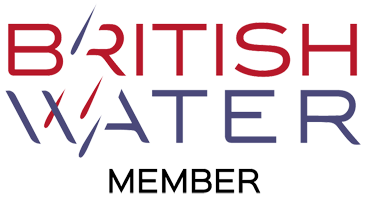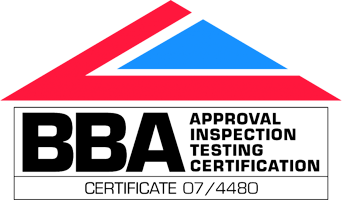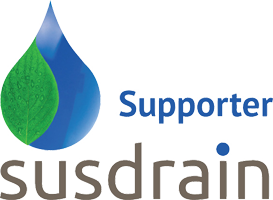Author Archives: leah
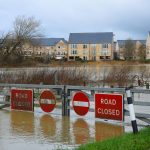
Crate Expectations
With strengthening focus on flooding and water quality, CIRIA’s advice to oversize crate-based attenuation tanks by 10% has never been more relevant, says Stuart Crisp, UK manager at Advanced Drainage Systems (ADS).
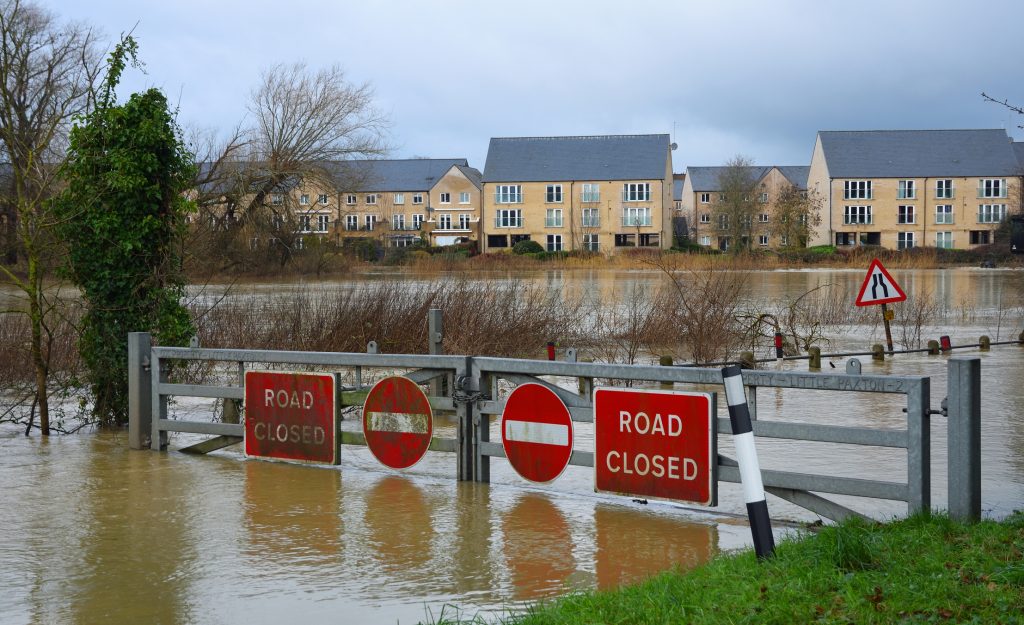
There’s a reason why the CIRIA SuDS Manual C753 suggests that “difficult to clean” SuDS attenuation systems, such as below-ground crates, should be oversized by 10%: there is a risk that sediment will build up in them, reducing their storage capacity.
With increasing legislation to manage flood risk and to prevent pollution, and more intense rainfall events, this advice becomes even more pertinent. There is a higher volume of water for SuDS devices to deal with and, when these events follow dry spells, more particulate matter and pollutants are swept along with surface water.
Unfortunately, this need to upsize crate-based attenuation tanks by 10% is often overlooked, thanks to focus on originally calculated target storage volumes. Furthermore, if the development is ‘value-engineered, the capital cost saving also often focusses on the original target storage volume. Up-sizing is often disregarded and, if the design is substituted for another type of attenuation system, the implications for water quality and the effectiveness of the treatment train are ignored.
The result is an increased risk of flooding and an increased risk to water quality.
Risk-based approach
The SuDS manual suggests a risk-based approach to designing SuDS management trains. Considering sediment, this means assessing: how much is likely to build up, depending on the location, how that load might change over time, and how often and easily devices will need to be cleaned.
Clause 21.5.3 of the manual explains the rationale for upsizing below-ground attenuation by 10%, while Table 21.2 shows the potential loss of storage capacity. Typically, commercial developments suffer from the highest sediment loading, followed by car parks, high-density residential developments and highways.
Removing sediment is also necessary to protect water quality and to avoid the negative impacts of pollutants. The predicted type, quantity and concentration of pollutants governs the choice of natural or manufactured SuDS element that would be most suitable.
Some underground attenuation systems, such as ADS’s StormTech arched system with its Isolator Row, are designed with in-built treatment systems which can be easily cleaned using standard equipment. This can negate the need for – and cost of – upstream treatment devices, while still protecting attenuation capacity and water quality.
Pay now or pay later
With the anticipated implementation of Schedule 3 of the Flood and Water Management Act 2010, SuDS adopting bodies will be looking hard at maintenance issues. Asset owners will need to be assured that the SuDS they are taking on will perform as designed throughout their whole lives.
Short-term savings in capital cost, which skimp on capacity and compromise water quality, can lead to long-term problems and greater whole-life costs, resulting in higher commuted sums for developers and an additional, avoidable cost burden on UK plc.
If a system is claimed to be exempt from the 10% up-sizing guidance, evidence that the system can be completely and easily cleaned should be demanded.
For more information on Advanced Drainage Systems, visit www.adspipe.co.uk.
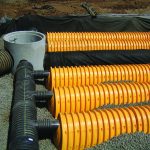
Future-proofing for Schedule 3
With legislation mandating SuDS and their adoption for new developments on the horizon, developers and designers need to upskill to ensure future designs meet tough new standards.
The Government’s recent announcement that it intends to implement Schedule 3 of the Flood and Water Management Act 2010, is a game changer for SuDS. It means that SuDS adoption is expected to be mandatory in England, as it has been in Wales since 2019. In Scotland, Schedule 3 has not been implemented, but SuDS is generally a requirement within planning legislation.
“While developers currently have the right to connect drainage systems into sewers, that is unlikely to be the case anymore,” explains Stuart Crisp, UK manager at Advanced Drainage Systems (ADS). “Instead, they will have to show that they have included SuDS in their schemes and demonstrate how that SuDS system can be maintained over the lifetime of a development.”
Subject to a consultation later this year, implementation of Schedule 3, which includes SuDS approval and adoption, is expected in late 2024. That means that there is less than two years for concerned professionals to get up to speed with the range and implications of possible solutions, both above and below ground.
“Designers will have to think about more than just hydraulic design, to include whole life maintenance and treatment train to deal with water quality issues and specific pollutants,” says Crisp. “There will probably be a transition period as Schedule 3 comes in, but it makes sense to upskill now in order to future-proof designs.”
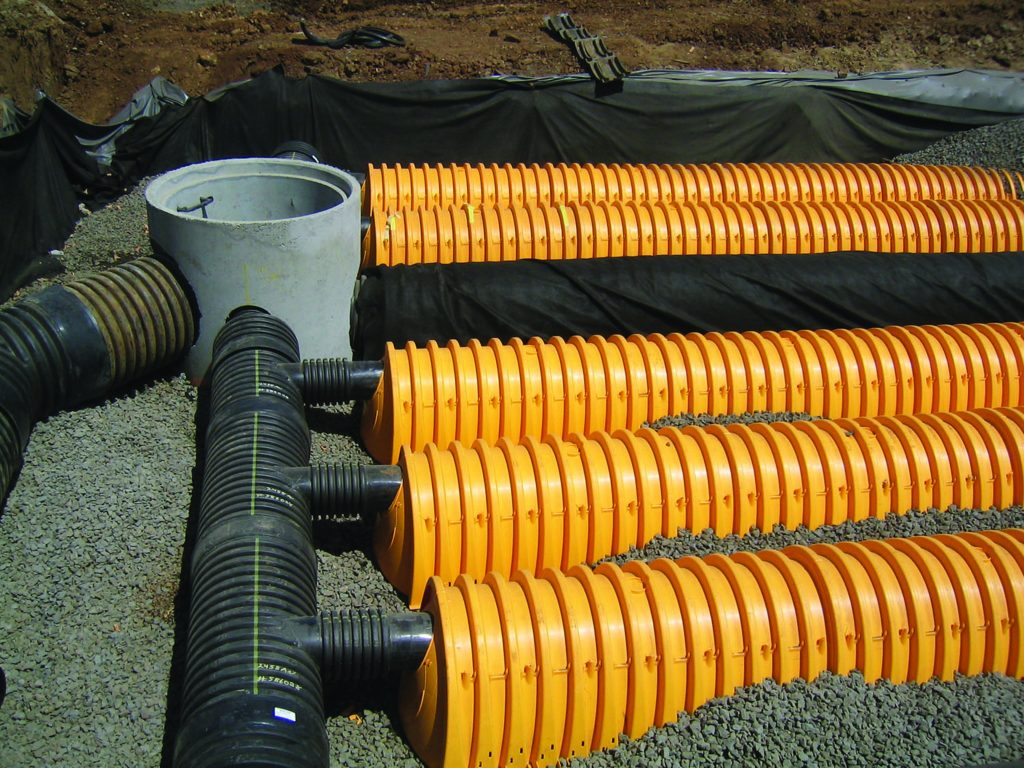
Currently, SuDS can be adopted by water companies as long as systems comply with the Design and Construction Guidance (DCG) which sets out how SuDS should be delivered. However, it is not compulsory for a developer to jump through the adoption hoops, leading to some assets not being of a prescribed, consistent standard of quality and performance or properly maintained and monitored, leading to problems down the line.
DCG was updated last year to include arch-shaped below-ground attenuation structures, such as ADS’s StormTech. StormTech offers a flexible and cost-efficient alternative to other below-ground attenuation structures such as crates or large-diameter pipes, with the benefit of built-in pollution treatment, reducing the extent of additional treatment elsewhere in the SuDS system.
It is expected that Schedule 3 will change the adopters of SuDS to become SuDS approving bodies (SABs) which will be within unitary councils or county councils. And it will bring in new statutory guidance, taking over from DCG to cover design, construction and operation over an asset’s lifetime.
“The statutory requirements in England are likely to be more onerous than both DCG and the current non-statutory standards in terms of what will be acceptable for planning approval and adoption after construction,” warns Crisp. “SuDS adoption becoming mandatory, with few exceptions, will raise the bar. Happily, poor quality products and poorly executed designs are likely to disappear from the market.”
For anyone looking to start the upskilling process now, manufacturer training and CPDs, such as those on below-ground attenuation offered by ADS, are already available and should include information on legislation, best practice and comparable systems.
For more information on Advanced Drainage Systems, visit www.adspipe.co.uk.
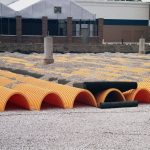
Water Quality and Data: A Matter of Trust
SuDS designs must consider water quality and water quantity in parallel – and use robust design data to avoid problems for asset owners, warns Stuart Crisp, UK manager at Advanced Drainage Systems (ADS).
SuDS design is becoming ever more complex. There’s a growing awareness that we must look after our water quality more carefully, backed up by policy such as the Plan for Water, published last year.
Where there are risks that surface water will carry pollutants, it must be treated, whether using natural or proprietary components, to reduce them to where they are not considered harmful to the environment. Where pollutant loads are low, natural vegetative SuDS may be able to do that job. Where they are higher, some form of manufactured treatment may be needed.
The asset owner needs to be assured that all the components of a SuDS system will perform as designed in relation to water quality as well as water quantity – and that they will continue to do so over the lifetime of the development. That includes ensuring that the data related to the pollutant removal capability of those components is robust. Otherwise, there is a risk that an asset becomes a liability.
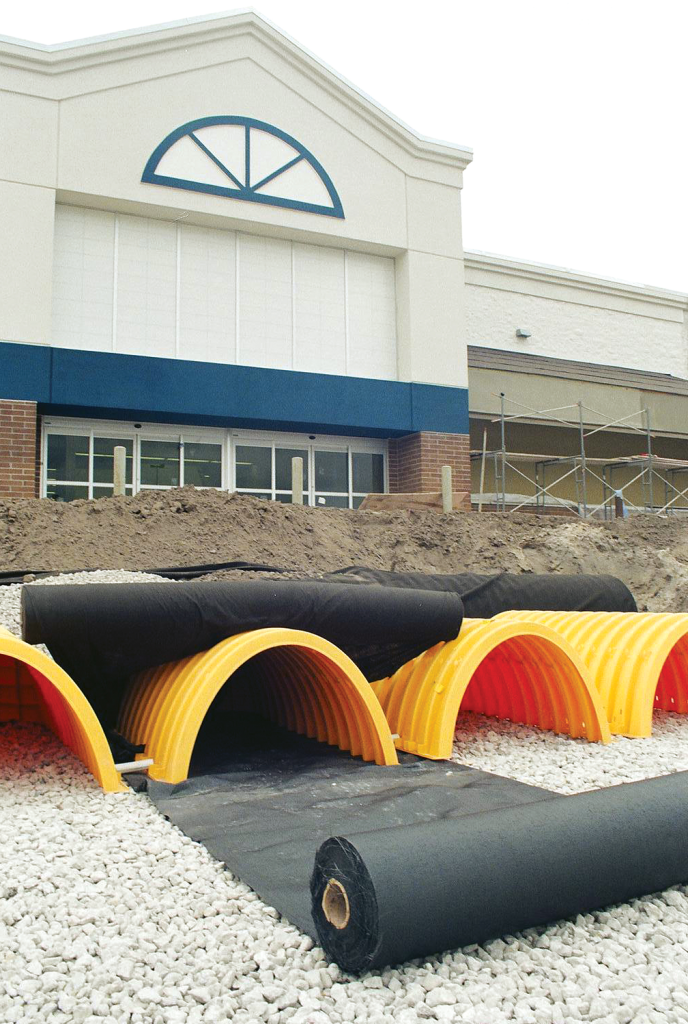
Designing for water quality
The CIRIA SuDS Manual C753 suggests a risk-based approach for designing water quality in SuDS management trains – the series of components that make up the drainage system. It provides pollution hazard indices for different types of site, and for three forms of pollution: total suspended solids (TSS), metals and hydrocarbons. It also gives mitigation indices (MIs) for natural SuDS components.
The designer must then select components whose combined MIs meet or exceed the pollution hazard indices for the predicted pollutants, noting that only 50% of the published MI value can be used for components downstream of the first treatment stage.
For manufactured components, British Water’s 2022 how to guide, Applying The CIRIA SuDS Manual (C753) Simple Index Approach To Proprietary Manufactured Stormwater Treatment Devices, provides a method for calculating mitigation indices for TSS, metals and hydrocarbons. This allows manufacturers of treatment devices to publish their MIs to a recognised methodology and designers can select the right combination of elements in a SuDS management train using reliable data, verified by a third party, to meet the pollution hazard indices of a development area.
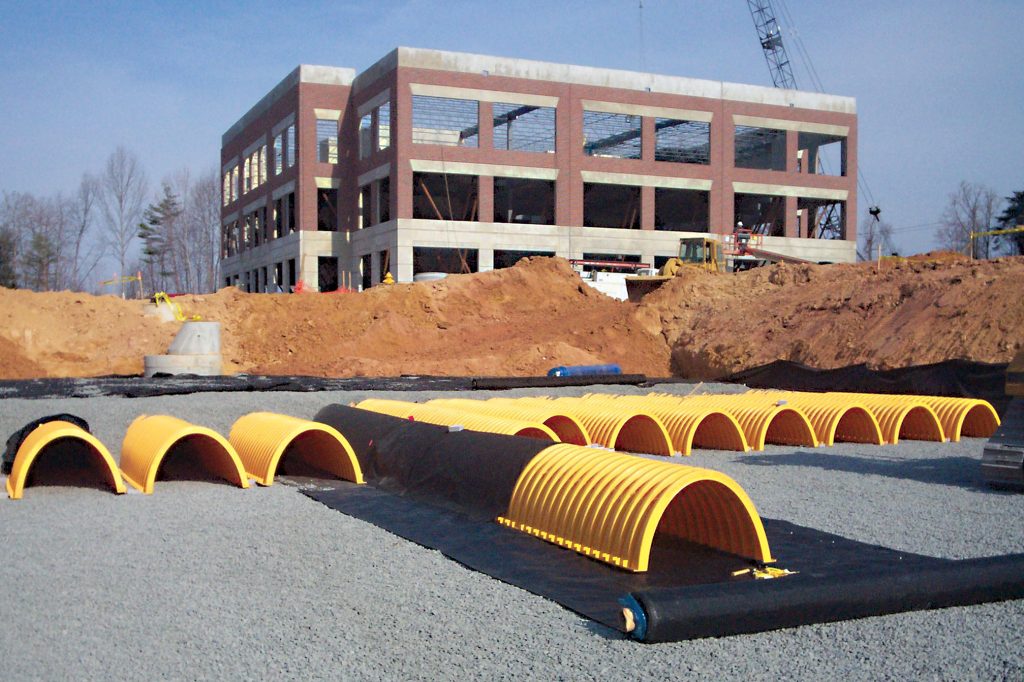
Adopting a problem
Although it now looks like Schedule 3 of the Flood and Water Management Act 2010 may not be activated until 2025, England will need to meet more demanding requirements for water quality. At this point, the body adopting the SuDS must ensure that they are taking on something that performs as claimed over the whole of its lifetime.
Our advice would be to do due diligence to determine how MIs have been derived, what methodology was applied and to insist that the process and results have been verified by a third party expert.
For more information on Advanced Drainage Systems, visit www.adspipe.co.uk.
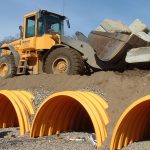
Three is the Magic Number
Stuart Crisp, UK manager of Advanced Drainage Systems (ADS), looks at looming legislation which will mandate SuDS and their adoption will require new skills for developers and designers.

In January 2023, the Government announced plans to finally implement Schedule 3 of the Flood and Water Management Act 2010, which will make the adoption of SuDS mandatory in England, as it has been in Wales since 2019. This is a game-changer for SuDS.
While developers currently have the right to connect drainage systems into sewers, that is unlikely to be the case anymore, without prior justification and consent.

Instead, they will have to show that they have included SuDS in their schemes and demonstrate how that SuDS system can be maintained over the lifetime of a development.
Subject to a consultation later this year, implementation of Schedule 3, which includes SuDS approval and adoption, is expected in late 2024. This means that there is less than two years for concerned professionals to get up to speed with the range and implications of possible solutions, both above and below ground.
Designers will have to think about more than just hydraulic design, to include whole life maintenance and treatment train to deal with water quality issues and specific pollutants. There will probably be a transition period as Schedule 3 comes in, but it makes sense to upskill now in order to future-proof designs.
Currently, SuDS can be adopted by water companies as long as systems comply with the Design and Construction Guidance (DCG) which sets out how SuDS should be delivered. However, it is not compulsory for a developer to jump through the adoption hoops. The end result is that some assets that do meet prescribed and consistent standards of quality and performance, may not be properly maintained and consequently there are problems down the line.
DCG was updated last year to include arch-shaped below-ground attenuation structures. One such system offers a flexible and cost-efficient alternative to other below-ground attenuation structures such as crates or large-diameter pipes, with the benefit of built-in stormwater quality management, reducing the extent of additional treatment required elsewhere in the SuDS system.
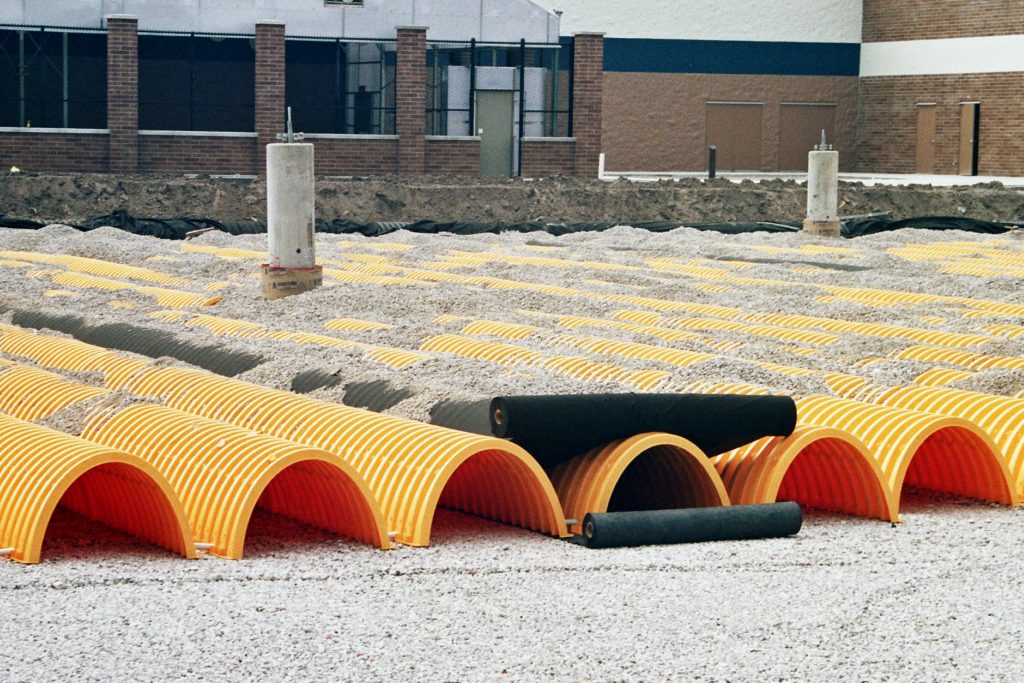
It is expected that Schedule 3 will change the assessment and adoption of SuDS to become SuDS approving bodies (SABs) which will be within unitary councils or county councils. And it will bring in new statutory guidance, taking over from DCG to cover design, construction and operation over an asset’s lifetime.
The statutory requirements in England may be more onerous than both DCG and the current non-statutory standards in terms of what will be acceptable for planning approval and adoption after construction. SuDS adoption becoming mandatory, with few exceptions, will raise the bar. Happily, poor quality products and poorly executed designs are likely to be challenged and disappear from the market.
For anyone looking to start the upskilling process now, training and CPDs are already available from some manufacturers and should include information on legislation, best practice and comparable systems.
For more information on Advanced Drainage Systems, visit www.adspipe.co.uk.
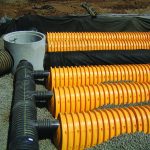
SuDS: Maintenance Matters
Designers need a better understanding of the maintenance requirements of different SuDS components to ensure that the systems they design will perform as intended. Stuart Crisp, UK manager at Advanced Drainage Systems (ADS), reports.
The issue of SuDS maintenance has always been a thorny one. Research suggests that the question of who will be responsible for the maintenance, and the cost of it, has been a prime factor in their slow uptake in the United Kingdom.
With the Government’s intention to implement Schedule 3 of the Flood and Water Management Act 2010 (FWMA) in England, making the installation and adoption of SuDS mandatory, concerns over maintenance issues again come to the fore. Developers, designers and installers need to understand the maintenance implications for alternative solutions considered for a project (in addition to, for example, hydraulic performance, structural integrity and water quality) and then offered to the adopting body responsible for the long-term operation of the SuDS asset. For underground attenuation devices, these vary significantly.
The more onerous the maintenance requirements, the higher the risk of them not being properly executed. The impacts of poor maintenance regimes and difficult-to-clean systems can be significant, increasing the risk of blockages – leading to loss of capacity and flooding – and pollutants washing out into water bodies.
Guidance
The SuDS Manual, CIRIA C753, recognizes that underground attenuation crates are ‘difficult to clean’ and that their capacity will reduce over time. Section 21.5.3 of the manual recommends that the size of crates should be increased by 10% to allow for accumulation of sediment. This applies even when a maintenance programme is deployed, since it isn’t always possible to remove all sediment during cleaning. Commercial developments, high density residential development, car parks and highways face the highest potential loss of storage, according to the guidance.
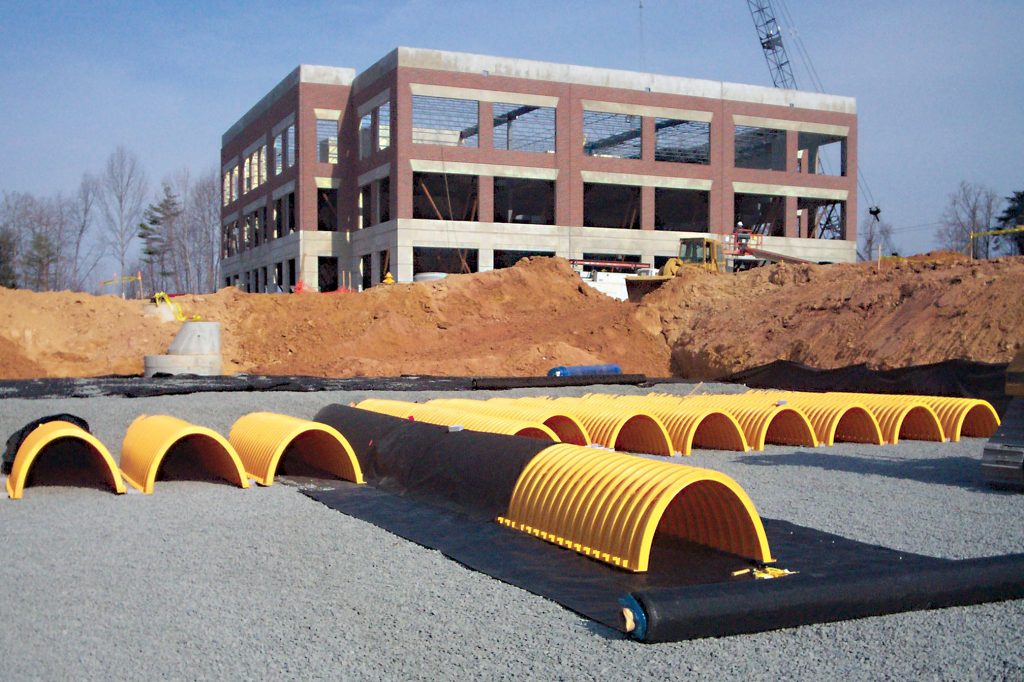
For both crates and large diameter pipes, some form of silt separation and removal system upstream is normally required to slow down the rate of sediment build-up and to remove some of the pollutants that cling to those particles. These upstream components must also be inspected and cleaned at intervals prescribed in a SuDS maintenance plan.
In designing its StormTech underground attenuation device, ADS sought to remove the need for costly upstream pre-treatment. An inbuilt ‘Isolator Row’ – essentially a modified version of the standard StormTech elliptical arches – collects the sediment before the water moves into the main body of the system.
Independent tests have demonstrated that the Isolator Row removes over 80% of total suspended solids (TSS), together with the metals, hydrocarbons, phosphorus, nitrogen, and other surface water pollutants that cling to them. The Isolator Row is easily accessed via a closely located manhole, and can be cleaned out with standard sewer-cleaning equipment.
Natural SuDS need maintenance too
Natural SuDS, as well as engineered ones, also need regular and planned maintenance. These range from frequent interventions such as litter picking and inspection of inlets and outlets to more occasional and seasonal activities such as vegetation management and removal of silt build-up.
Again, failure to maintain natural attenuation components such as ponds can have negative impacts. A 2018 study of SuDS in East Kilbride by the University of Glasgow, published in The Glasgow Naturalist, found that pollutants in some SuDS ponds were hindering amphibian breeding and development and that more frequent monitoring and management would be wise.
Whether natural or engineered SuDS, or a combination, maintenance regimes and their associated cost, should not be a barrier to their implementation. However, it is important that maintenance issues are understood, planned and communicated at the earliest stages of a project.
For more information on Advanced Drainage Systems, visit www.adspipe.co.uk.
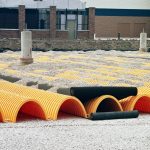
Three is the Magic Number
Stuart Crisp, UK manager of Advanced Drainage Systems (ADS), looks at looming legislation which will mandate SuDS and their adoption will require new skills for developers and designers.
In January 2023, the Government announced plans to finally implement Schedule 3 of the Flood and Water Management Act 2010, which will make the adoption of SuDS mandatory in England, as it has been in Wales since 2019. This is a game-changer for SuDS.
While developers currently have the right to connect drainage systems into sewers, that is unlikely to be the case anymore, without prior justification and consent.
Instead, they will have to show that they have included SuDS in their schemes and demonstrate how that SuDS system can be maintained over the lifetime of a development.
Subject to a consultation later this year, implementation of Schedule 3, which includes SuDS approval and adoption, is expected in late 2024. This means that there is less than two years for concerned professionals to get up to speed with the range and implications of possible solutions, both above and below ground.
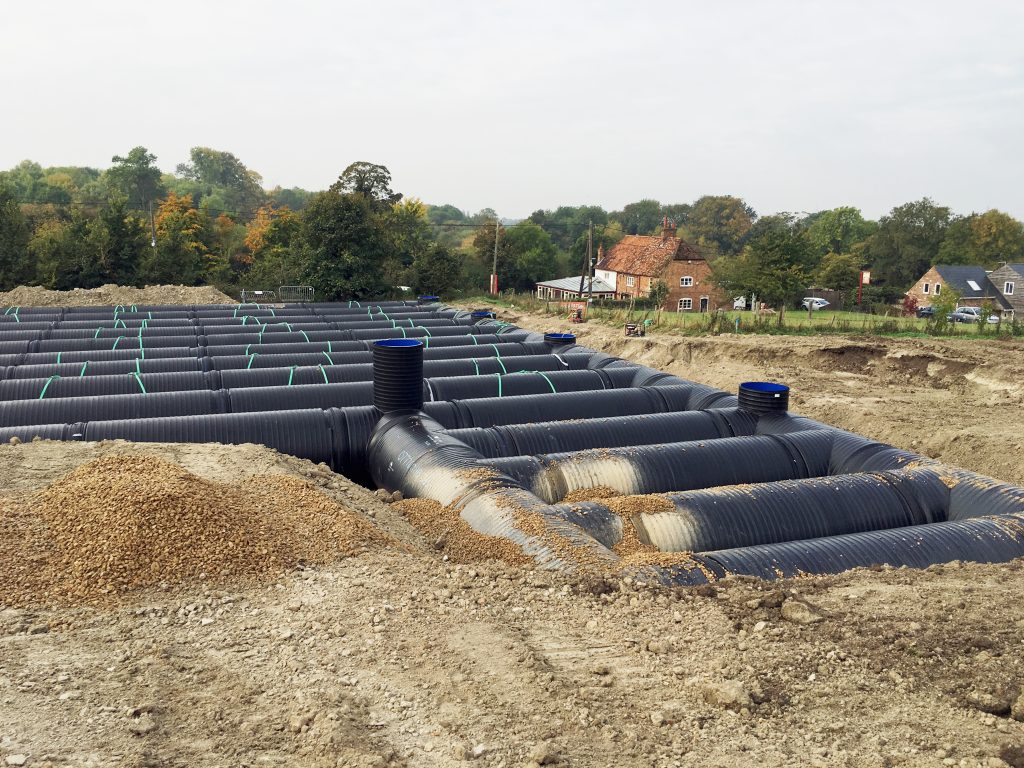
Designers will have to think about more than just hydraulic design, to include whole life maintenance and treatment train to deal with water quality issues and specific pollutants. There will probably be a transition period as Schedule 3 comes in, but it makes sense to upskill now in order to future-proof designs.
Currently, SuDS can be adopted by water companies as long as systems comply with the Design and Construction Guidance (DCG) which sets out how SuDS should be delivered. However, it is not compulsory for a developer to jump through the adoption hoops. The end result is that some assets that do meet prescribed and consistent standards of quality and performance, may not be properly maintained and consequently there are problems down the line.
DCG was updated last year to include arch-shaped below-ground attenuation structures. One such system offers a flexible and cost-efficient alternative to other below-ground attenuation structures such as crates or large-diameter pipes, with the benefit of built-in stormwater quality management, reducing the extent of additional treatment required elsewhere in the SuDS system.
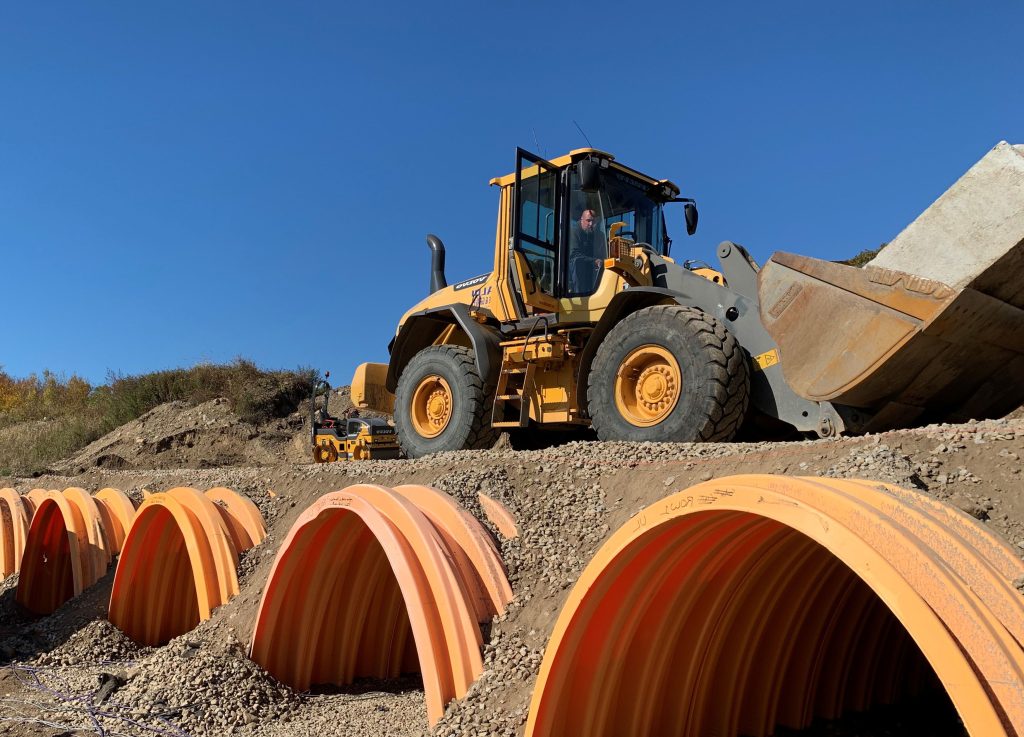
It is expected that Schedule 3 will change the assessment and adoption of SuDS to become SuDS approving bodies (SABs) which will be within unitary councils or county councils. And it will bring in new statutory guidance, taking over from DCG to cover design, construction and operation over an asset’s lifetime.
The statutory requirements in England may be more onerous than both DCG and the current non-statutory standards in terms of what will be acceptable for planning approval and adoption after construction. SuDS adoption becoming mandatory, with few exceptions, will raise the bar. Happily, poor quality products and poorly executed designs are likely to be challenged and disappear from the market.
For anyone looking to start the upskilling process now, training and CPDs are already available from some manufacturers and should include information on legislation, best practice and comparable systems.
For more information on Advanced Drainage Systems, visit www.adspipe.co.uk.
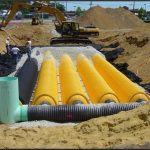
Water Qualitatively and Quantitively
Stuart Crisp, UK manager of Advanced Drainage Systems (ADS), looks at how ‘good’ SuDS addresses water quality as much as water quantity when it comes to managing water down a ‘treatment train’.
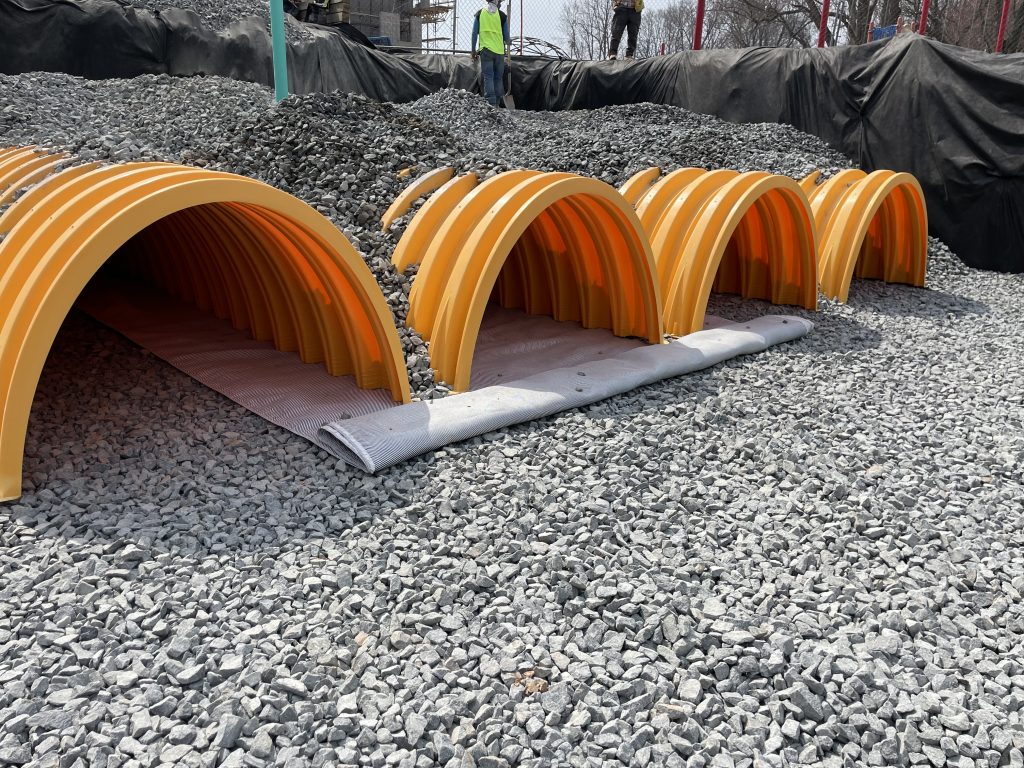
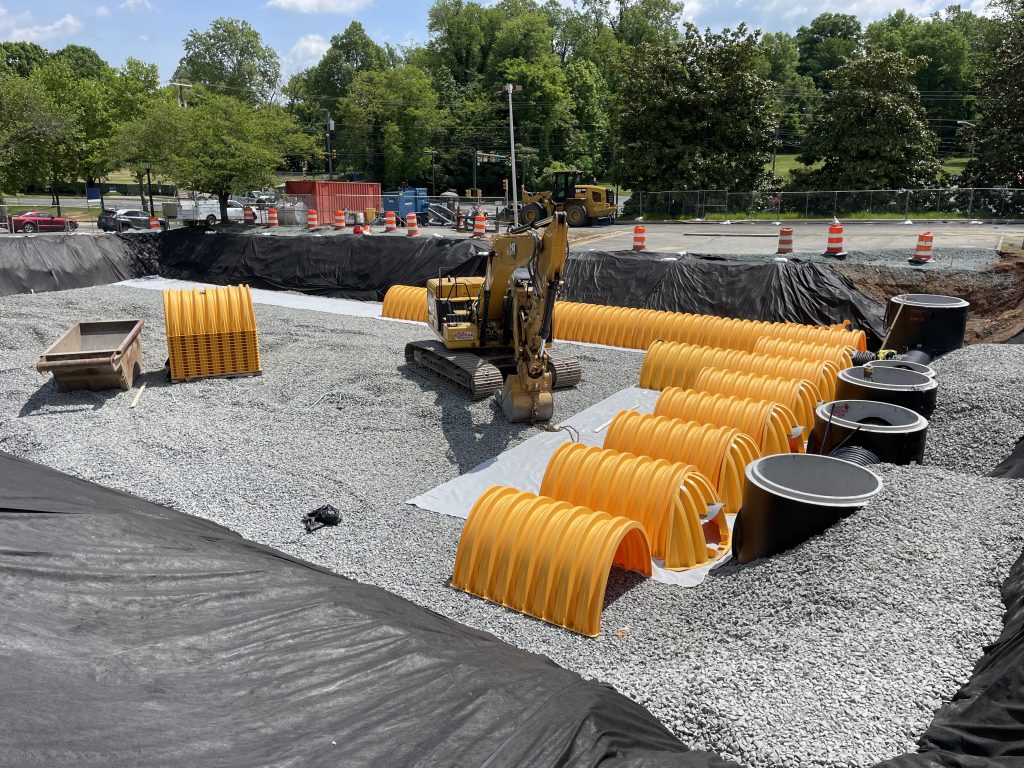
Historically, driven by legislation, there’s a tendency to focus on water quantity – how to use SuDS to reduce or delay release of stormwater into sewers and prevent flooding. However, new legislation requires the additional focus on water quality. The SuDS treatment train considers water quality and prevention of pollution from stormwater runoff (alongside flood risk mitigation), with the level of treatment provided based on the anticipated levels and types of pollution.
A SuDS treatment (or management) train should start with prevention such as reducing impermeable surfaces, to reduce run-off and remove sources of pollution. Next comes source control, where rainfall is dealt with close to where it falls by infiltration-based elements such as soakaways, rain gardens and permeable pavements. Site control sees water managed within a local area, for instance directing water to a soakaway or infiltration device and then onto an attenuation pond or tank. Finally, regional control would see a system that could handle run-off from several sites, perhaps resulting in a detention basin or wetland.
The SuDS Manual, C753, published by CIRIA, prescribes a risk-based approach to designing SuDS for water quality. If pollution risks are deemed to be low, then SuDS designers can prioritise water quantity, amenity and biodiversity. If they are medium, then all considerations must be balanced. And if they are high, water quality evaluation must take precedence. It should however be noted that in all cases, including medium and low pollution risk sites, appropriate mitigation should be put in place to reduce the risk of pollution.
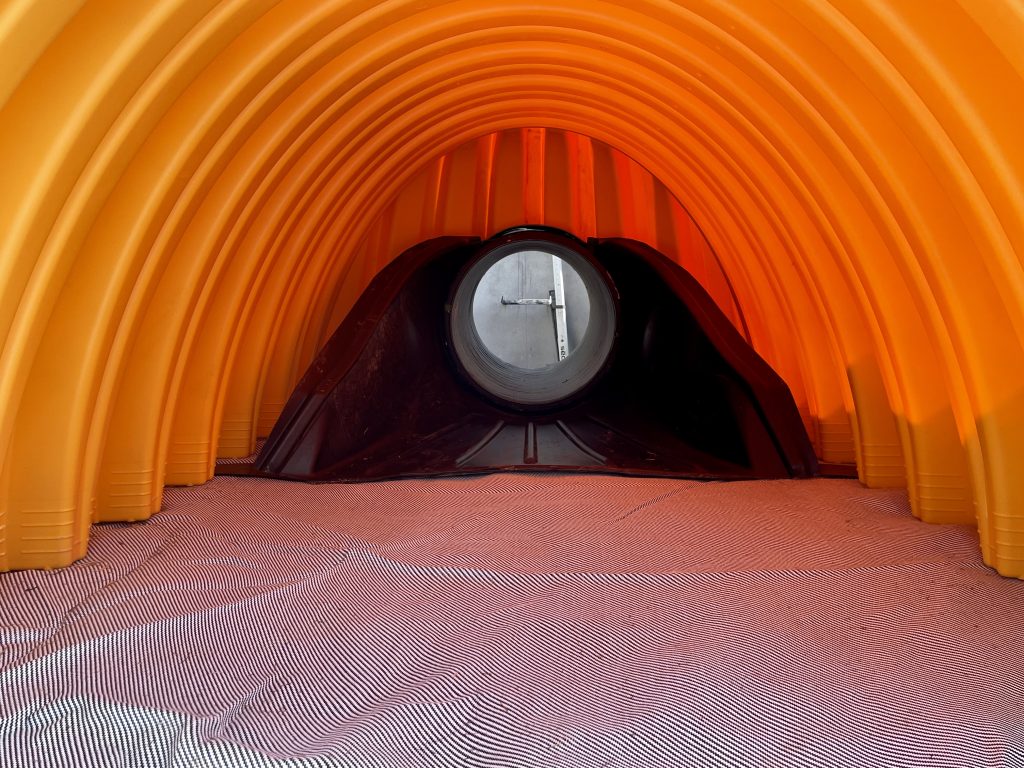
There is a range of water quality treatment measures that can be included in a SuDS train. Sometimes it is possible to use a completely natural SuDS train to deal with both water quantity and quality issues. At other times, the best solution combines natural and engineered SuDS elements, or may require proprietary manufactured elements only. This could be due to high levels of pollution loading or the space available.
There are four main types of pollutant that can be found in stormwater run-off: sediments, metals, hydrocarbons and nutrients. Sediments, often referred to in pollution mitigation as total suspended solids (TSS), is particulate matter. It includes tiny particles of soil, such as silt and clay, which have been dislodged by rainwater as it passes over the run-off surfaces.
Metals and metal compounds can be dissolved in run-off or attached to silts and sediments in the water. Copper and zinc are most commonly found in surface water in the UK but there can be cadmium and other toxic metals too. Although plants require very small amounts of copper and zinc to grow, higher concentrations can be damaging to them.
Hydrocarbon pollution comes with run-off from roads, car parks and areas where machines operate and are maintained, due to oil and fuel spills, tyre and brake wear. Changing climate means that rainfall events can be further apart but more intense, which can lead to higher concentrations of pollutants from roads, as they build up for longer before being washed away.
Nutrient pollution, usually nitrogen or phosphorous based, can come from sources such as run-off from agricultural land where fertiliser has been used or combined sewer overflows (CSOs), where sewage and surface water are mixed and discharged into bodies of water. They can lead to algal blooms, which reduces oxygen levels in the water and can negatively impact on aquatic habitats.
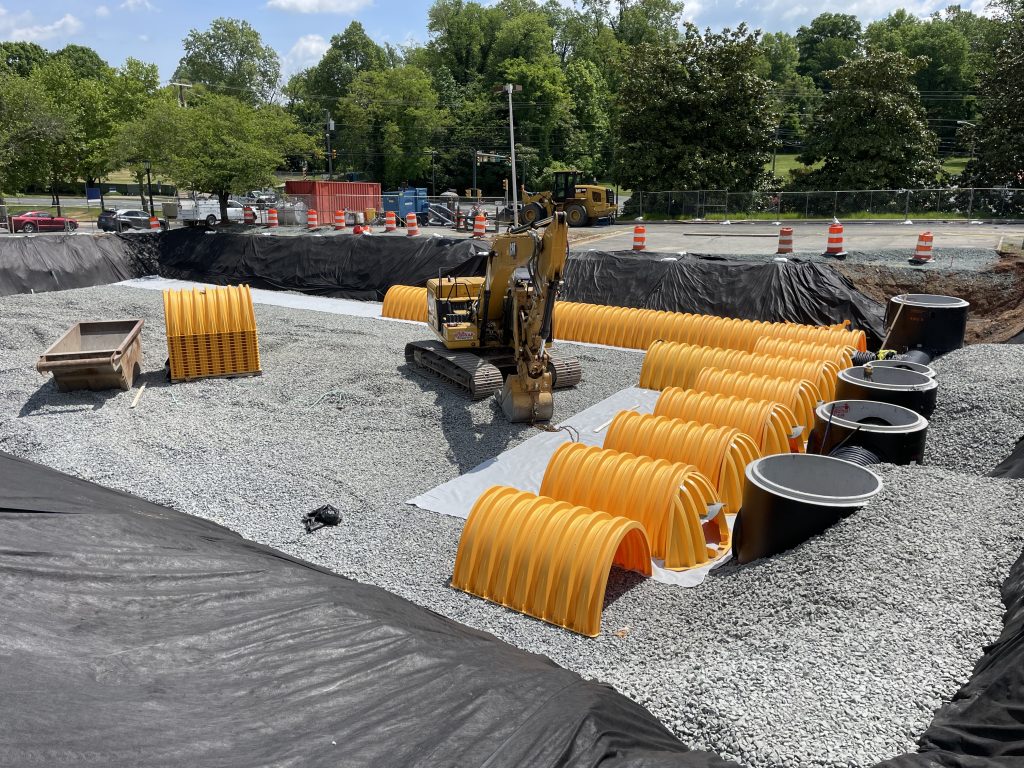
Capturing TSS pollution should generally be the focus of water treatment strategies in SuDS design since this removes both the solid particles and any pollution clinging to them. This can be done using a natural SuDS feature, such as planting for bioretention or a swale. Manufactured components such as filtration devices, silt traps or vortex separators can also be used upstream to remove solids before water is discharged into ponds, for instance.
Removal of sediment and solids is also important from a water quantity perspective. Build-ups reduce the capacity of a water storage element, whether natural or manufactured. How and when to remove sediment should be considered at the design stage and should be part of a planned maintenance regime.
Without a means of reducing suspended solids upstream of an attenuation device, sediment build-up within the device can reduce its efficiency over time. Some recently introduced underground arch-shaped SuDS attenuation devices have their own built-in systems for intercepting solids which are fast and simple to maintain.
Mitigation indices
The SuDS Manual sets out a simple method for dealing with water pollution risks, requiring the determination of pollution hazard indices for the area under consideration and then matching a SuDS device with matching mitigation indices.
In Table 26.2, the manual provides pollution hazard indices for a range of applications and for three types of pollution: TSS, metals and hydrocarbons. So, for example, for a busy public car park such as a supermarket or hospital, the index for TSS is 0.7, for metals is 0.6 and for hydrocarbons 0.7.
The next step is to identify a form of SuDS treatment that can provide the necessary mitigation indices, either as a single treatment stage or using a combination of components. The Manual has a table for that too, Table 26.3. However, this table only provides mitigation indices for natural SuDS components. The mitigation indices for the natural SuDS components were compiled by a team of experts, drawing information from a selection of published papers.
Mitigation indices for proprietary manufactured treatment systems must be provided by the manufacturer using recognised test methods and 3rd party verified data.
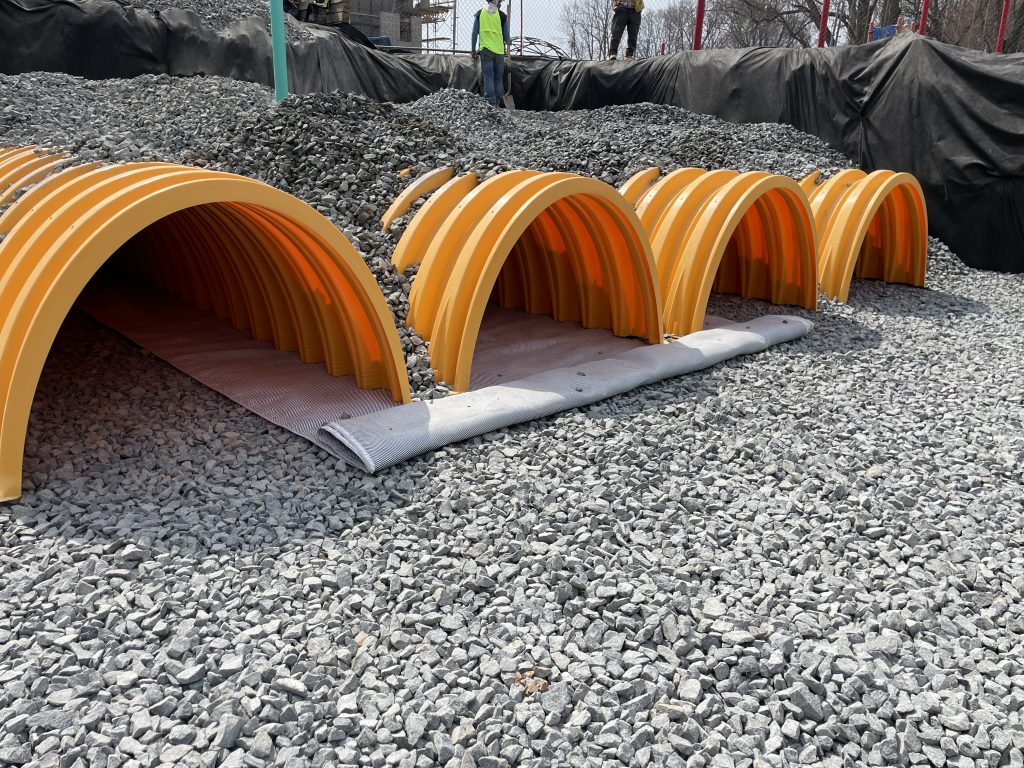
British Water has published a Code of Practice for the Assessment of Manufactured Treatment Devices Designed to Treat Surface Run-off. It uses rainfall time-series data for the UK to determine an appropriate treatment flow rates based on first-flush principles and uses a combination of two established test protocols – the German Deutsches Institut für Bautechnik (DIBt) and the New Jersey Corporation for Advanced Technology (NJCAT) from the US – to create the British Water test methods.
In 2022 British Water published a ‘how to’ guide, Applying The CIRIA SuDS Manual (C753) Simple Index Approach To Proprietary/Manufactured Stormwater Treatment Devices, which provides a calculation methodology to derive mitigation indices for TSS, metals and hydrocarbons based on the British Water Code of Practice, or the DIBt or the NJCAT, test results. This enables manufacturers of proprietary treatment products to have their mitigation indices published so that they can be considered as part of a SuDS management train.
British Water publishes a List of Assessed Surface Water Treatment Devices. More details on the British Water web site.
For more information on Advanced Drainage Systems, visit www.adspipe.co.uk.
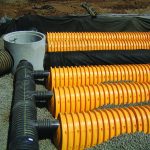
Designing for Water Quality Using Mitigation Indices
Now there are verified mitigation indices for engineered components says Stuart Crisp, UK manager at Advanced Drainage Systems (ADS).
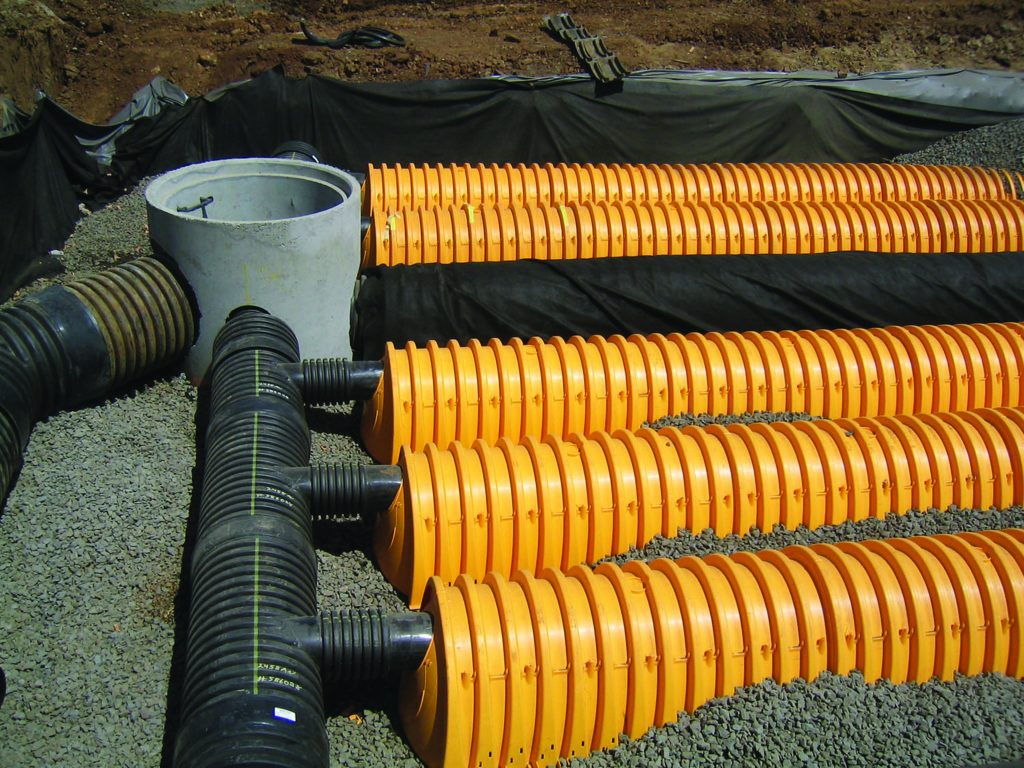
The publication of the Plan for Water by the Department for Environment, Food & Rural Affairs (Defra) in April this year signalled the Government’s intention to tackle water pollution. Clearly, one of the ways to do this is by using a well-designed SuDS management train which considers both water quantity and quality, deploying SuDS components that are appropriate for the levels and types of pollution present in the surface water.
This is recognised in the Plan, with reference to Schedule 3 of the Flood and Water Management Act 2010, which will make adoption of SuDS for new developments mandatory. The Government had announced in January 2023 that Schedule 3 would be finally implemented in England, as it already has been in Wales, possibly coming into force in 2024, subject to consultation.
SuDS are often thought of as a way to manage water quantity by reducing flows into sewers and hence reducing activation of combined sewer overflows (CSOs) which discharge raw sewage into water bodies. SuDS should also be designed to manage water quality directly by removing pollutants where it is carried in surface water. The CIRIA SuDS Manual, C753, prescribes a risk-based approach, setting out the expected levels of pollution for different development types and then defining how natural and engineered SuDS elements, used as a single entity or together, can be used to remove the various forms of pollution.
When it comes to engineered SuDS components, designers and specifiers can turn to British Water, the body which represents water and wastewater companies. Having published a code of practice in 2016 and a ‘how to’ guide for manufactured stormwater treatment devices in 2022, the organisation is now hosting a list on its website of engineered SuDS components which have had their pollution treatment information verified by an independent third party expert. The ADS StormTech system, with its Isolator Row – a built-in water quality treatment device – has recently been added to British Water’s list of assessed surface water treatment devices.
Types of pollution
There are four main types of pollutant that can be found in stormwater run-off: sediments, metals, hydrocarbons and nutrients. Sediments, often referred to in pollution mitigation as total suspended solids (TSS), is particulate matter including particles of soil. Metals and metal compounds can be dissolved in run-off or attached to silts and sediments in the water. Copper and zinc, which are most commonly found in surface water in the UK, can damage plants in higher concentrations.
Hydrocarbon pollution comes with run-off from roads, car parks and areas where machines operate and are maintained, due to oil and fuel spills, tyre and brake wear. Changing climate means that rainfall events are further apart but more intense, leading to higher concentrations of pollutants, as they build up for longer before being washed away.
Nutrient pollution, usually nitrogen or phosphorous based, can come from sources such as run-off from agricultural land where fertiliser has been used or combined sewer outfalls, where wastewater and surface water are discharged into bodies of water. They can lead to algal blooms, which reduces oxygen in the water and can negatively impact on aquatic habitats.
Mitigation indices
The SuDS Manual’s method for dealing with water pollution risks starts by determining pollution hazard indices for the area under consideration. In Table 26.2, the manual provides pollution hazard indices for a range of land uses and for three types of pollution: TSS, metals and hydrocarbons. So, for example, for a busy public car park such as a supermarket or hospital, the index for TSS is 0.7, for metals is 0.6 and for hydrocarbons 0.7.

The next step is to identify a SuDS treatment train that can provide the necessary mitigation indices, either a single stage or using a combination of components. The manual has a table for that too, Table 26.3. However, this table only provides indices for natural SuDS components, stating that proprietary treatment systems must demonstrate that they can address each of the contaminant types to acceptable levels.
For engineered components, British Water’s two documents – Code of Practice for the Assessment of Manufactured Treatment Devices Designed to Treat Surface Run-off and ‘how to’ guide, Applying The CIRIA SuDS Manual (C753) Simple Index Approach To Proprietary/Manufactured Stormwater Treatment Devices – provide a methodology to calculate mitigation indices for TSS, metals and hydrocarbons.
The mitigation indices for ADS StormTech’s Isolator Row are 0.8 for TSS, 0.6 for metals and 0.7 for hydrocarbons = 0.7. This means that it meets the requirements for medium pollution hazard applications and the TSS requirements of high pollution hazard applications and can be used as a combined SuDS attenuation and water quality treatment system without the need for additional components within the treatment train.
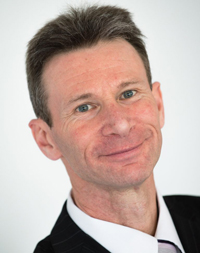
Stuart Crisp is UK Manager for Advanced Drainage Systems (ADS). ADS is America’s largest manufacturer of thermoplastic corrugated drainage pipes and a specialist in water management systems. StormTech has a long and successful track record with over 50,000 below ground SuDS attenuation system installations using in excess of 3m units.
Originally published in Water magazine September 2023
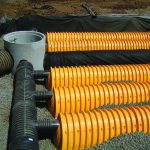
SuDS for Water Quality
Designing SuDS to remove pollution from surface water requires a risk-based approach, matching likely levels of pollution with the performance of SuDS elements. Stuart Crisp, UK manager at Advanced Drainage Systems (ADS), reports.
Sustainable Urban Drainage Systems (SuDS) should be designed with both water quantity and water quality in mind. Yet often the water quality element is overlooked, or down-specified or removed altogether in a misnomered ‘value engineering’ exercise.
One of the challenges for designers is that the CIRIA SuDS Manual, C753, only defines the performance of natural SuDS components in the removal of pollutants. For engineered components, manufacturers must demonstrate that the component(s) selected will reduce the contaminant types to acceptable levels.
One way to do that is to check whether the manufactured component is on British Water’s list of assessed surface water treatment devices. To appear on the list, data relating to a component’s pollution treatment ability must have been verified by an independent expert.
Risk-based approach
The SuDS Manual prescribes a risk-based approach to designing for water quality, defining pollution risks by way of pollution hazard indices. In Table 26.2, the manual provides the indices for a range of land uses and for three types of pollution: total suspended solids (TSS) such as tiny soil particles, metals and hydrocarbons. For instance, a busy public car park such as a supermarket or hospital, would have indices of 0.7 for TSS, 0.6 for metals and 0.7 for hydrocarbons. The manual then provides generic mitigation indices for natural SuDS components for the three types of pollution in Table 26.3.
British Water, which represents water and wastewater companies, has published two documents which provide guidance on how to calculate mitigation indices for engineered SuDS components. In 2016 it published a Code of Practice for the Assessment of Manufactured Treatment Devices Designed to Treat Surface Run-off. And in 2022 it followed that up with a ‘how to’ guide, Applying The CIRIA SuDS Manual (C753) Simple Index Approach To Proprietary/Manufactured Stormwater Treatment Devices.
British Water’s ‘how to’ guide provides a method for calculating mitigation indices for TSS, metals and hydrocarbons based on test results derived from its code of practice. This means that manufacturers can calculate and publish mitigation indices for their treatment products so that they can be considered as part of a SuDS management train.
On its website, British Water provides a list of engineered SuDS components and their independently verified mitigation indices. ADS StormTech, with its Isolator Row, was recently added to the list, the only system that combines attenuation and pollution removal, often without the need to add a treatment device upstream of the attenuation chambers.
It should be noted that removal of TSS is also important from a water quantity perspective. Build-ups can reduce the storage and discharge capacity of a water storage element, whether natural or manufactured. How and when to remove sediment should be considered at the design stage and should also be part of a planned maintenance regime.

For more information on Advanced Drainage Systems, visit www.adspipe.co.uk.
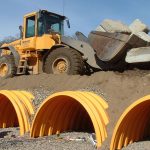
A Case for Adoption
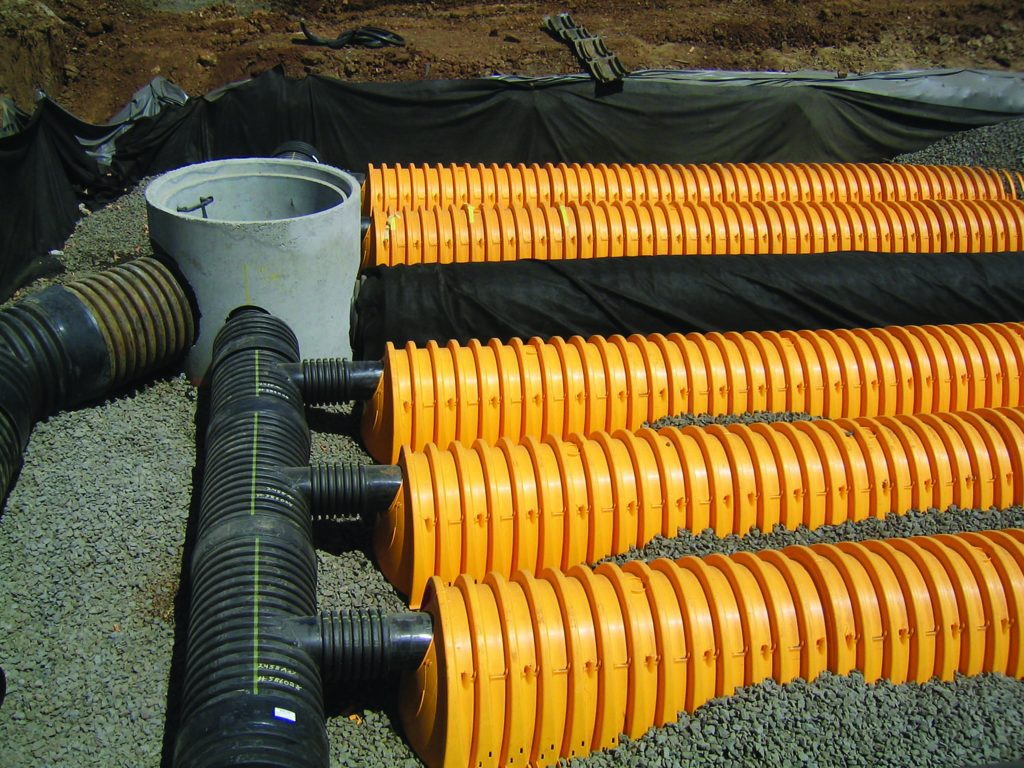
With Schedule 3 still over the horizon in England (if it happens at all), the Design and Construction Guidance for adoptable sewers covers minimum standards of design and construction of sewers. And recent changes to DCG give the green light to arch-shaped attenuation chambers – given certain criteria are met. Stuart Crisp, UK manager of Advanced Drainage Systems (ADS), reports.
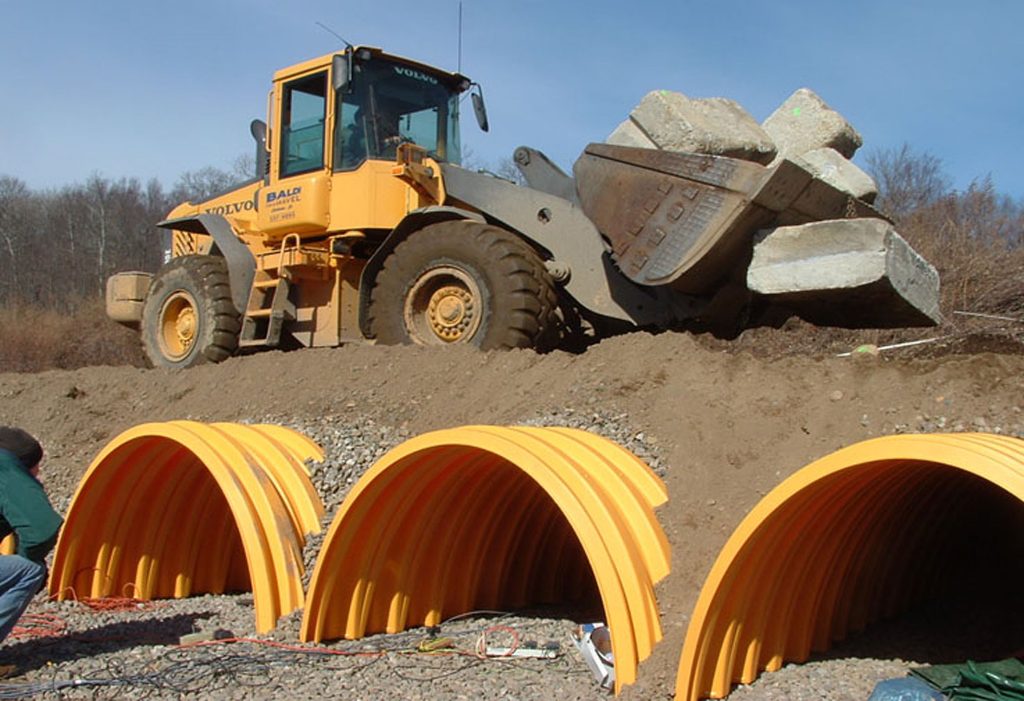
Ofwat’s Design and Construction Guidance (DCG) for adoptable sewers remains the most important document defining minimum standards of design and construction of adoptable sewers in England, including certain SuDS components. It has been updated to include information about arch-shaped below-ground SuDS attenuation chambers. This makes it easier for water companies to adopt such drainage infrastructure.
Previously, there was no reference to arch-shaped attenuation structures in the DCG which has meant that it has been more difficult for water companies to adopt them. That all changes with the addition of this extra section.
The DCG first came into force on April 1st 2020, replacing the long-standing Sewers for Adoption guidance. Developers who design and install sewerage systems in line with the DCG can expect to have their systems adopted by their local water companies – although it should be noted that water companies must be involved at the earliest stages of design and specification to ensure that local requirements and nuances are met.

One of the notable things about the DCG is that it includes information on sustainable drainage systems (SuDS) and that the definition of a sewer has been broadened to include certain SuDS components. This means that water companies in England can adopt SuDS components under Section 104 of the Water Industry Act 1991 which satisfy the requirements set out in DCG in the same way that they can adopt pipes, manholes and other sewerage infrastructure.
Version 2.2 of the DCG, first available through the Water UK website in November last year, identifies arch-shaped attenuation structures for the first time and requires that such systems can demonstrate full compliance with all the new requirements.
The relevant information can be found in section C7.8 of the document which covers Tanks, in clause C7.8.4d which says:
“d) where half pipe or arch structures are proposed, the design must (in addition to the above) demonstrate how the system can be cleaned/jetted and done so without damage or erosion of base materials or membrane. Further design evidence should outline how, in areas of a high-water table, groundwater is kept out of the system and, when positioned under highways, that the loading criteria is acceptable to both undertaker and adopting Highway Authority (if applicable).”
Any changes to the DCG must first be assessed and accepted by the Independent Sewerage Adoption Panel, which is made up of representatives from water companies and developers and then a recommendation made to Ofwat for their approval.
The inclusion of arch-shaped structures, such as ADS’s StormTech, has been initially well-received by water companies – and paves the way for developers to offer them without having to do additional work to prove their suitability.
For more information on Advanced Drainage Systems, visit www.adspipe.co.uk.
